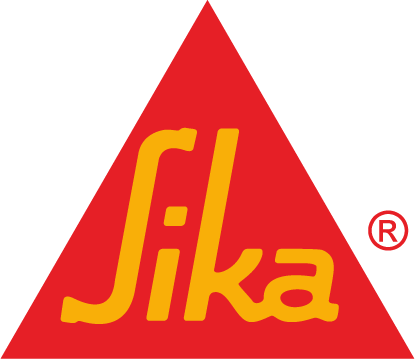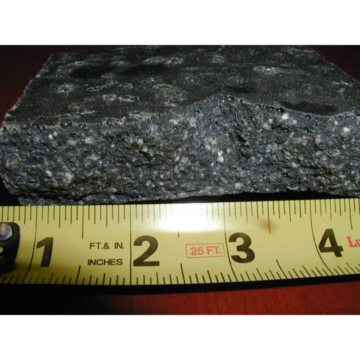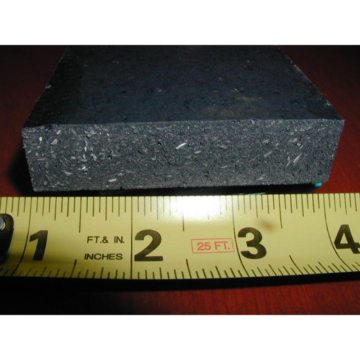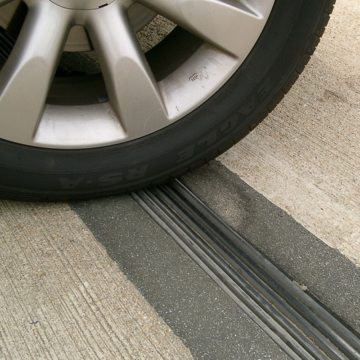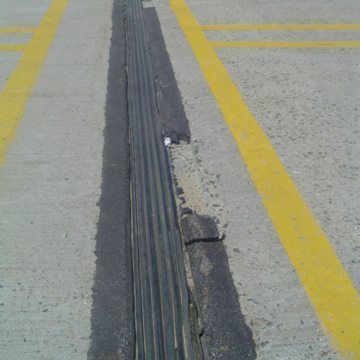Aggregate Loading
Aggregate Loading in Nosing Materials of Parking Deck Expansion Joint Systems
So you’ve endured the usual parade of expansion joint manufacturers and their reps through your office. The purpose of these visits is, of course, to get you to specify or buy their joint systems. Seeing a difference between systems and sorting out the litany of claims for performance is exhausting.
As you wade through the information, however, one topic that should come up (and raise it if it doesn’t) is aggregate loading.
As you already know, the rubber extrusion of these “membrane/nosing” systems is locked into the blockout at the concrete slab edge with a nosing material. The nosing material is usually a mix of a flexible resin and an aggregate filler.
The aggregate serves two desirable functions:
- it improves the compressive strength of the nosing material, and
- it extends the yield of the resin.
- Compressive strength is necessary to resist the effects of suddenly applied vehicle loads especially during braking, turning, and under acceleration from a standstill.
- Extending the yield is good for the customer because it brings the cost of the system down by thinning out the expensive resin. Extending the yield as much as possible is a hidden temptation for manufacturers because it translates into lower cost and higher profit.
Succumbing to the temptation to over-extend resins with aggregate can have disastrous effects on performance of the nosing material in this application.
The Negative Effects of Heavy Aggregate Loading are:
- Brittleness
- Propagation of snow plow impact into bond lines causing extensive failure
- Inability of material to handle concrete flexing–resulting in cracking and leaking
- Inability of material to handle differential expansion–resulting in cracking and leaking
- Cracking over time caused by normal traffic–resulting in leaking
- Installation difficulties including: long mix times, difficulty achieving proper aggregate wetting-out, labor-intensive troweling, and rough appearance.
Some suppliers are loading as much as one part resin to 4 1/2 and even SIX parts aggregate. Not only this, but the choice of large mesh aggregate makes the problem worse. EMSEAL chooses to supply a dust-free, silica-free, fine aggregate for compressive strength, combined with a chopped glass fiber (for extension and flexibility). As you can imagine, this is more costly to us than an aggregate of blended mesh sands and inexpensive gravel, but the absence of call backs easily justifies the choice.
You may have heard differing interpretations of EMSEAL’s claims of what constitutes “conservative aggregate loading”. You may also have been told that EMSEAL is vague about its loading ratios. If you read our literature, however, you will see that we clearly state our aggregate loading by volume AND weight so as to avoid confusion. Here’s what our guide spec for our Thermaflex systems say:
Ratio by Weight of Liquid Resin to Aggregate | Not to Exceed 1:2
Ratio by Volume of Liquid Resin to Aggregate | Not to Exceed 1: 1.3
Take your pick. Either way, if your supplier is giving you more than two parts aggregate to one part resin you are sacrificing a balance of hardness, strength, flexibility and durability that has set the standard for cold-applied nosing material over 25 years of supply.
Compressive Strength
A balance in hardness, flexibility and strength is essential for lasting performance of nosing materials. This balance is necessary to handle the forces and wear of expected traffic while also being forgiving of more rigorous activities. If compressive strength and thermal coefficient of expansion were the deciding physicals in the successful nosing material performance then why not simply use concrete to lock the expansion joint down? The answer is that concrete, like excessively loaded nosing resin, is too brittle and lacks the balance of physicals needed in the application.
Polyurethane chemistry combined with aggregate options has allowed the development of nosing materials that can be forgiving of errant snow-plow hits while having sufficient compressive strength to absorb suddenly applied traffic impact. While it is not expected that any supplier warrant materials against snow-plow activity that violates National Parking Association standards, we do live in a real world. The occasional hit of a non-rubber tipped blade is likely. When this occurs the conservatively-loaded nosing material will absorb the shock and shave away slightly at the point of impact if necessary. This means that the shock is not propagated to the bondline watertightness is preserved. By contrast, field evidence shows that high-compressive strength materials will shatter, crack and shock the bondline over an area considerably in excess of the point of impact.
Proper Installation
Of course a product, no matter its formulation, is only as good as the applicator installing it. Regardless of the physical properties various nosing materials they are all likely to crack near the leading edge if not properly installed. All winged compression seal type systems rely on the nosing material being properly supported all the way up to the joint edge–either by a process of tucking the material under the flange of the seal (wing) or by setting it into a setting bed. If either of these steps is improperly executed the system will, in time, crack about 3/4-inch (20mm) from the joint edge.
Thank you for your consideration and continued support of EMSEAL’s products. As we move forward, one satisfied building owner at a time, we find validation in our shared approach and in the words of a nineteenth century observer of society and the construction arts, John Ruskin:
“It is unwise to pay too much, but it’s worse to pay too little. When you pay too much you lose a little money—that is all. When you pay too little you sometimes lose everything, because the thing you bought was incapable of doing the things it was bought to do. The common law of business balance prohibits paying a little and getting a lot. It can’t be done. If you deal with the lowest bidder, it is well to add something for the risk you run, and if you do that you will have enough to pay for something better.”
Effects of Aggregate Loading
Heavily Loaded: A sample of heavily loaded resin shows the abundance of aggregate. This makes the nosing material very dry, very hard, very brittle, and very likely to fail under snow-plow impact, deflection of the deck, and differential expansion in relation to the concrete and/or simply as a consequence of normal traffic over time.
When snow plows hit heavily-aggregate-loaded nosings they shatter and send the shock into the adjacent nosing resulting in widespread damage.
Conservatively Loaded: A sample of lightly loaded resin shows a good balance of aggregates and resin. The result is sufficient compressive strength to resist plow impact, and withstand traffic rigors, while not sacrificing flexibility.
When snow plows hit conservatively loaded nosing, it shaves locally, dissipates the shock, and leaves the joint functional and watertight.
Inspection in June, 2004 of 8-year old Thermaflex nosing material at Ronald Reagan International Airport, Middle/North parking garage, shows localized shaving of nosing material to the right of the leading edge of the tire. Caused by errant snow-plowing the impact scarring is superficial and repairable and the joint remains watertight.
Within one winter of installation, heavily-aggregate loaded nosing showed evidence of lack of forgiveness to errant snow-plow activity. Shock propagation through the rigid nosing material caused bond-line failure far beyond the point of impact and in addition caused severe damage to the punched flanges of the sealing extrusion.
Link to Parking Deck Joint Selection Guide
Update: January 16, 2019

